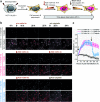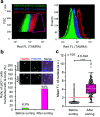Intra Q-body: an antibody-based fluorogenic probe for intracellular proteins that allows live cell imaging and sorting
- PMID: 36091915
- PMCID: PMC9400599
- DOI: 10.1039/d2sc02355e
Intra Q-body: an antibody-based fluorogenic probe for intracellular proteins that allows live cell imaging and sorting
Abstract
Although intracellular biomarkers can be imaged with fluorescent dye(s)-labeled antibodies, the use of such probes for precise imaging of intracellular biomarkers in living cells remains challenging due to background noise from unbound probes. Herein, we describe the development of a conditionally active Fab-type Quenchbody (Q-body) probe derived from a monoclonal antibody (DO-1) with the ability to both target and spatiotemporally visualize intracellular p53 in living cells with low background signal. p53 is a key tumor suppressor and validated biomarker for cancer diagnostics and therapeutics. The Q-body displayed up to 27-fold p53 level-dependent fluorescence enhancement in vitro with a limit of detection of 0.72 nM. In fixed and live cells, 8.3- and 8.4-fold enhancement was respectively observed. Furthermore, we demonstrate live-cell sorting based on p53 expression. This study provides the first evidence of the feasibility and applicability of Q-body probes for the live-cell imaging of intrinsically intracellular proteins and opens a novel avenue for research and diagnostic applications on intracellular target-based live-cell sorting.
This journal is © The Royal Society of Chemistry.
Conflict of interest statement
There are no conflicts to declare.
Figures






Similar articles
-
Visualizing intracellular target antigens in live cells.Trends Cell Biol. 2023 Apr;33(4):277-279. doi: 10.1016/j.tcb.2023.01.004. Epub 2023 Feb 7. Trends Cell Biol. 2023. PMID: 36759281
-
Ultra Q-bodies: quench-based antibody probes that utilize dye-dye interactions with enhanced antigen-dependent fluorescence.Sci Rep. 2014 Apr 11;4:4640. doi: 10.1038/srep04640. Sci Rep. 2014. PMID: 24721819 Free PMC article.
-
Creation of a Nanobody-Based Fluorescent Immunosensor Mini Q-body for Rapid Signal-On Detection of Small Hapten Methotrexate.ACS Sens. 2020 Nov 25;5(11):3457-3464. doi: 10.1021/acssensors.0c01404. Epub 2020 Nov 10. ACS Sens. 2020. PMID: 33169966
-
Protein labeling with fluorogenic probes for no-wash live-cell imaging of proteins.Curr Opin Chem Biol. 2013 Aug;17(4):644-50. doi: 10.1016/j.cbpa.2013.05.015. Epub 2013 Jun 3. Curr Opin Chem Biol. 2013. PMID: 23743124 Review.
-
Small-molecule-based protein-labeling technology in live cell studies: probe-design concepts and applications.Acc Chem Res. 2014 Jan 21;47(1):247-56. doi: 10.1021/ar400135f. Epub 2013 Aug 8. Acc Chem Res. 2014. PMID: 23927788 Review.
Cited by
-
Prediction of Single-Mutation Effects for Fluorescent Immunosensor Engineering with an End-to-End Trained Protein Language Model.JACS Au. 2025 Feb 10;5(2):955-964. doi: 10.1021/jacsau.4c01189. eCollection 2025 Feb 24. JACS Au. 2025. PMID: 40017789 Free PMC article.
-
Nanodroplet-Based Reagent Delivery into Water-in-Fluorinated-Oil Droplets.Biosensors (Basel). 2023 Jul 28;13(8):768. doi: 10.3390/bios13080768. Biosensors (Basel). 2023. PMID: 37622854 Free PMC article.
-
Single domain antibody: Development and application in biotechnology and biopharma.Immunol Rev. 2024 Nov;328(1):98-112. doi: 10.1111/imr.13381. Epub 2024 Aug 21. Immunol Rev. 2024. PMID: 39166870 Free PMC article. Review.
-
N‑Terminal Conjugation of a Near-Infrared Photosensitizer to an Antibody for Cancer Diagnosis and Treatment.ACS Omega. 2025 Jun 11;10(24):25596-25604. doi: 10.1021/acsomega.5c01083. eCollection 2025 Jun 24. ACS Omega. 2025. PMID: 40584339 Free PMC article.
-
Development of Luminescent Biosensors for Calprotectin.ACS Chem Biol. 2024 Jun 21;19(6):1250-1259. doi: 10.1021/acschembio.4c00265. Epub 2024 Jun 6. ACS Chem Biol. 2024. PMID: 38843544 Free PMC article.
References
-
- Los G. V. Encell L. P. McDougall M. G. Hartzell D. D. Karassina N. Zimprich C. Wood M. G. Learish R. Ohana R. F. Urh M. Simpson D. Mendez J. Zimmerman K. Otto P. Vidugiris G. Zhu J. Darzins A. Klaubert D. H. Bulleit R. F. Wood K. V. ACS Chem. Biol. 2008;3:373–382. doi: 10.1021/cb800025k. - DOI - PubMed
LinkOut - more resources
Full Text Sources
Research Materials
Miscellaneous

